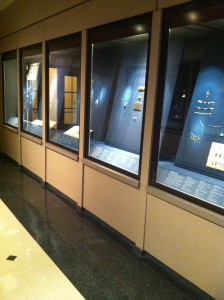
One of only four museums in the United States with a gallery space dedicated to its permanent jewelry collections, the Newark Museum is a little-known gem that deserves better recognition by jewelry lovers. To people unfamiliar with jewelry history the crime-plagued city of Newark may seem like an odd place for a museum committed to the display of jewelry, however from about 1850-1950 Newark was the fine jewelry manufacturing capital of the United States. According to Ulysses Grant Dietz, curator of decorative arts at the Newark Museum and author of “The Glitter and the Gold, Fashioning America’s Jewelry”, it is estimated that in 1929 approximately ninety percent of solid-gold jewelry made in the U.S. came from Newark factories.
The rise of the jewelry industry in Newark and the United States coincided with several major events all occurring in the decades around 1850: the gold rush in California; imposition of tariffs on imported silver; the Industrial revolution and the development of steam-driven machinery; and the development of railroads. Newark’s proximity to New York and its (then as now) cheaper real estate, made it a convenient place for manufacturers to build factories, yet still be close to the economic and fashion capital of the U.S.
Jewelry lovers will recognize many of the following jewelry manufacturers, but may not have realized that they were based in Newark: Unger, Kerr, Herper Brothers, Riker, Whiteside and Blank, and Krementz. The following pieces of jewelry were all on display during a recent visit to the Newark Museum (roll over the photos for captions):
Many lesser-known Newark companies such as Sloan and Co., Bernard M. Shanley, Andrew Hedges and Co. produced exquisite work under their own name and for well-known retailers such as Tiffany:
It’s hard to believe that this bracelet by Hedges was made in 1890, it’s so modern looking:
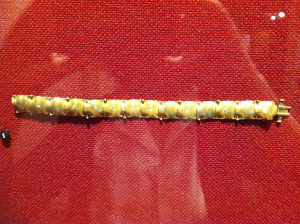
Tiffany actually had a large manufacturing facility in Newark from the late-19th century through the 1980’s that manufactured flatware and holloware, school rings, medals, membership badges, corporate service jewelry, silver jewelry, a little fine jewelry, and some stunning vanity, match, and cigarette cases.
To put Newark-made jewelry in context, the museum doesn’t limit itself to pieces produced locally. Their extensive collection includes masterpieces produced elsewhere including some that are part of their extensive Asian art collection:
The most spectacular piece of jewelry in the Newark Museum’s collection was not in residence during my visit because it was on loan to the Museum of the City of New York as one of the highlights of “Gilded New York”, an ongoing exhibit. Known as the Rehan Jewel for a former owner, it is an astounding example of plique a jour enameling by Marcus and Company, one of the greatest New York jewelry manufacturers of the late 19th and early 20th century.
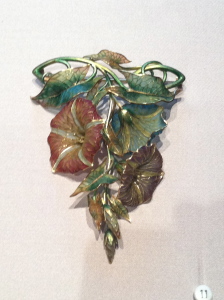
As stated on the museum’s website, “Gilded New York explores the city’s visual culture at the end of the 19th century, when its elite class flaunted their money as never before… through extravagant fashions, architecture, and interior design. The exhibition presents a lavish display of some 100 works, including costumes, jewelry, portraits, and decorative objects, all created between the mid-1870s and the early 20th century.” Some of my favorite pieces from the exhibition include:
And, of course, if you were the daughter of a corporate titan and going to a fancy dress ball you could always call on Maison Worth in Paris to run you up a little costume so that you could attend as one of Velazquez’s “Las Meninas”:
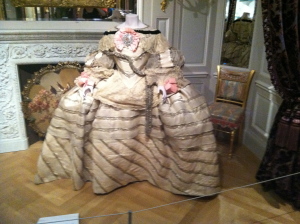
Location:
The Newark Museum is located at 49 Washington Street, Newark, NJ. Driving instructions are available on their website. Trains from New York Penn Station to Newark Penn Station are available, then take a taxi from the train station.
The Museum of the City of New York is located on Fifth Avenue, between 103rd and 104th streets.
“The Glitter & the Gold: Fashioning America’s Jewelry” is available through the Newark Museum’s Bookstore. The catalogue from “Gilded New York: Design, Fashion and Society” is available from the Museum of the City of New York’s Bookstore.
ShareFollow
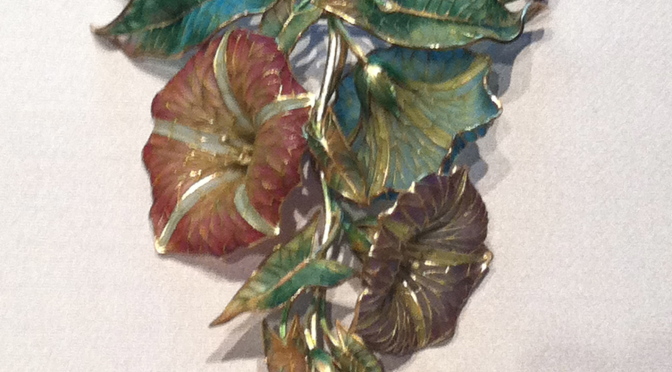

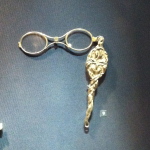
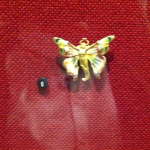


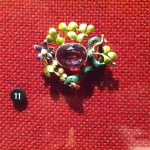

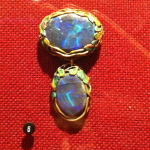
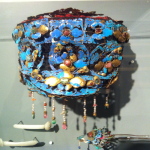
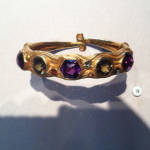

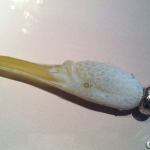
And let’s not forget the fabulous collection at the Museum of Natural History in D.C., part of the Smithsonian and home to the Hope diamond and many other spectacular things. Mostly unset cut gems and uncut stones, but some fashioned into jewelry.
Thanks for your suggestions and feedback. One other possibility is the Museum of Fine Arts in Boston. They regularly have major exhibits of jewelry and according to their website Yvonne Markowitz, their Curator of Jewelry, is the first endowed curator in a US museum with a position dedicated to the study of jewelry.
Also possibly the Virginia Museum of Fine Arts in Richmond, which has a Faberge collection (currently traveling). It’s mostly jeweled objects but they have a number of Faberge egg pendants too.
I’m guessing one of the museums is the Walters in Baltimore. Fabulous jewelry from ancient times up through amazing art nouveau by Lalique and Tiffany, maybe beyond. To see what they’ve got, click “artworks” on the home page and then choose to browse by category (one is jewelry).
Lisa,
Great post. What are the other 3 museums that have permanent jewelry collections in the US? Will you be writing posts about them, too? Thanks, Claire
Hi Claire,
I’m not sure what the other three museums that have permanent collections. That fact came from the Newark Museum’s website describing their current exhibit in the jewelry gallery. http://www.newarkmuseum.org/glitterandgold.html Lisa